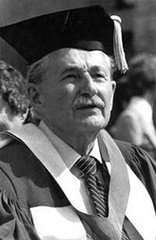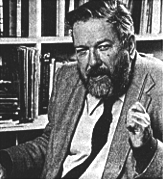Defining Conservatism in Alberta
Discussions from the media, to the water cooler, in classrooms, bedrooms, and in coffee shops are displaying a disturbing lack of understanding about the various dimensions of "conservatism" and "Conservatism" in Alberta. Stories and arguments that align Harper with Klein, Morton with Manning, Stelmach with Clark, and so on, are glossing over many of the intricacies of the parties and the movement.
What follows are broad strokes aimed at trying to flesh out the various dimensions of "conservatism" and "Conservatism" in Alberta. While of use in other provinces -- perhaps in other countries -- nowhere are the various dimensions of conservative thought more visible than in Alberta. The following is intended as the first-draft of a primer for discussing the right in Alberta. As always, your comments are welcome, along with permission to incorporate them into this work-in-progress.
Perhaps the simplest way to conceptualize an ideology like conservatism is to divide it into a series of functional dimensions. In this case, six seem especially pertinent (dramatic oversimplifications of each term are given in parentheses):
(1) MORAL CONSERVATISM* (a.k.a., NEO-conservatism; emphasis on traditional family values; often, but not always, tied to religious beliefs)
(2) SOCIAL CONSERVATISM*^ (opposition to social engineering, including affirmative action; emphasis on law, order and security)
(3) FISCAL CONSERVATISM^ (a.k.a., neo-liberalism; emphasis on fiscal orthodoxy, including balanced budgets, deregulation, privatization, debt repayment, and tax relief)
(4) POPULISM~ (a belief in grass-roots democracy, often in opposition to political partisanship and other top-down institutions like Parliament; often, but not always, mixed with libertarianism; see: Thomas Jefferson)
(5) HIGH TORYISM~ (a belief in parliamentary sovereignty, often in opposition to direct democracy and judicial activism; often accompanied by a communitarian/patriotic view of the state; see: Alexander Hamilton and Edmund Burke)
(6) LIBERTARIANISM (a belief in the sovereignty of the individual and the limitations of government in the moral, social, and economic spheres)
*The distinction between #1 and #2 is no doubt the trickiest. In every-day language, both moral and social conservatives have been lumped under the "SO-CON" label. While there is a correlation between the two sets of values, it's important to distinguish between the two. Logically, a person could be a moral conservative without being a social conservative (and vice versa).
^Both social and fiscal conservatism often favour limited state interference in the economy, and a guaranteed but limited social welfare system.
~This is where there is often a direct conflict within conservative ranks, between those who favour a grass-roots style of politics and those that favour an elite-driven version.
People do not have to conform to any one of these labels. In fact, few, if any conservatives are members of only one 'camp'. As mentioned, people with moral and social conservative tendencies are often referred to as "SO-CONS". People with moderate fiscal conservative leanings and tendencies toward "high toryism" -- without a touch of moral or social conservatism -- are often called "RED TORIES". In the United States, the "NEW RIGHT" consists of "neo-cons" and "neo-liberals". And so on. The point is not to pigeon-hole people into one class of conservatism. Quite the opposite.
Tracing the contours of conservatism in this way helps us make sense of Conservatism in places like Alberta. Some of the province's leading Tories have made strange bedfellows over the years. The media and public have either failed to notice these tensions or have failed to link them to the underlying ideological frictions. Let's have a look at some of the major players....
WILLIAM ABERHART -- Alberta's first Social Credit premier, his "vision" blended religious moral and social conservatism with an anti-system, populist outlook and a 'quirky' view of public finance. In reality, Aberhart's control over the party and the legislature was the polar opposite of grass-roots democracy, and his province-building strategy used the full capacity of the public purse. Ernest Manning is widely considered the heir to Aberhart's image.
PETER LOUGHEED -- Often called a 'red tory', Lougheed was a communitarian conservative who put Alberta first. In this sense, his battles with Trudeau resembled those fought between Aberhart and King decades earlier. Lougheed, too, had a loose grasp of fiscal conservatism, but, unlike Aberhart, tended to keep social and moral conservatism out of official government policy. This, along with his penchant for social welfare spending, has earned him the label "Pink Peter" (a reference to his possible 'pinko'-socialist ties), particularly popular among Ralph Klein's followers. Lougheed's son is currently in the running for president of the Alberta PC's, by the way.
JOE CLARK -- "Joe-Who" has become synonymous with red-toryism in Canada. His view of the country as a "community of communities"; his firm stance against social and moral conservatism; his willingness to relax the rules of fiscal orthodoxy; and his support of parliamentary sovereignty have earned him the admiration of red tories and the hatred of the New Right.
PRESTON MANNING -- It's not difficult to see the ties between Preston Manning's Reform movement and his father's Social Credit legacy. While the religious fervour with which Aberhart campaigned was missing from Preston's speeches, the latter attempted the same blend of populism, moralism and social conservatism. To this, Preston added a firm stance in favour of fiscal orthodoxy.
RALPH KLEIN -- Where to start? King Ralph is very difficult to pin-down in terms of his conservative beliefs, largely because he seldom spoke in ideological terms, and because his actions were often contradictory. Without a doubt, though, he was a social and fiscal conservative, with morally conservative tendencies. While his image was certainly one of a grass-roots politician, in touch with the 'real people' of Alberta, his iron grip on the Party spoke otherwise. (This is a common theme among populist Conservative leaders, from Aberhart to the Mannings to Klein: once in power, they often end up being more tory than grass-roots. This speaks more to the iron law of oligarchy than to their personal integrity, in my opinion.)
STOCKWELL DAY -- Wet-suit aside, Stock was a moral, social and fiscal conservative.
TED MORTON -- Ted is a conservative's Conservative. He promotes moral, social and fiscal conservatism, with a populist/republican concern for the little-guy, and a high tory aversion to judicial actism. I fail to see any libertarianism in Ted's beliefs, but I am bound to be corrected. If he has them, he's the ideal, pure conservative. (As a side-note: Ted Morton's great at promoting each of the conservative dimensions, but his willingness to leave hard edges is proving more divisive than Harper's approach, as outlined below. Some may fault Ted for being too uncompromising; others may fault Harper for being too compromising. It all depends on your perspective.)
JIM DINNING -- Liberal. Period. Someone tell me where Dinning fits in any of these categories of conservatism and I'll be glad to post it here.
ED STELMACH -- It's still too early to tell, but Ed's style and his team have heavy connections with Peter Lougheed's red tories. He seems a little less tied to fiscal conservatism than Klein, and has yet to display the same image as a social conservative. Moral conservatism? Not likely. The pressure to 'go green' while remaining close with business and putting Alberta-first may force Stelmach into the red tory mold.
STEPHEN HARPER -- I know, I know. Harper's not really from Alberta. But I can't leave him off the list, precisely because his persona (since becoming Conservative Party leader) has proven itself the most moderate mixture of all six forms of conservatism. As a strategist, his ability to interpret and frame policy in each of these areas is remarkable. As the person charged with uniting the old PC's and Alliance, his manoevering has been impecable.
Harper boldly put same-sex marriage back on the table, framing it in terms of a free vote in order to appease libertarians, and accepting its outcome to the relief of red tories. His law, order and security agenda has social conservatives on-side, without offending too many populists. His tax policies are strong enough to please fiscal conservatives, while his creativity on issues like income trusts and income-splitting are surprising many red tories and moral conservatives. His specific proposals for Senate reform -- while still in the works -- offer a little something for tories and populists, alike. Libertarians? You may have to wait for your piece of the pie, but Harper's proving better than the guys on the other side of the aisle. In short, Harper is proving himself as one of the best at balancing the various demands of conservatism.
The purpose of this discussion has been to highlight how not all C/conservatives are created equal, particularly in Alberta. The next time you hear someone painting us all with the same brush, think twice.




